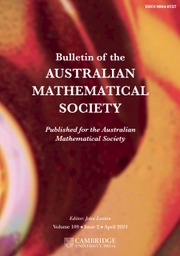No CrossRef data available.
Article contents
Quasi-codivisible covers
Published online by Cambridge University Press: 17 April 2009
Abstract
Core share and HTML view are not available for this content. However, as you have access to this content, a full PDF is available via the ‘Save PDF’ action button.
In this paper quasi-codivisible covers are defined and investigated relative to a torsion theory (T, F) on Mod R. It is shown that if (T, F) is cohereditary, then a right R-module M has a quasi-codivisible cover whenever it has a codivisible cover. Moreover, it is shown that if (T, F) is cohereditary, then the universal existence of quasi-codivisible covers implies that the ring R/T (R) must be right perfect. The converse holds when (T, F) is pseudo-hereditary.
- Type
- Research Article
- Information
- Copyright
- Copyright © Australian Mathematical Society 1986
References
[1]Bass, H., “Finitistic dimension and a homological generalization of semi-primary rings”, Trans. Amer. Math. Soc. 95 (1960), 466–488.Google Scholar
[2]Beachy, J.A., “Cotorsion radicals and projective modules”, Bull. Austral. Math. Soc. 5 (1971), 241–253.Google Scholar
[4]Fuller, K. and Hill, D., “On quasi-projective modules via relative projectivity”, Arch. Math. (1970), 369–373.Google Scholar
[6]Lambek, J., Torsion theories, additive semantics, and rings of quotients (Lecture Notes in Mathematics, 177. Sorubger-Verlag, Berlin and New York, 1971).Google Scholar
[7]Pareigis, B., “Radikale und kleine moduln”, Bayer. Akad. Wiss. Math.-Natur. Kl. Sitzungsber, 11 (1966), 185–199.Google Scholar
[9]Stenstrom, B., Rings and modules of quotients (Lecture Notes in Mathematics, 237. Springer-Verlag, Berlin and New York, 1971).Google Scholar
[10]Wu, L. and Jans, J., “On quasi-projectives”, Illinois J. Math. 11 (1967), 439–448.Google Scholar


